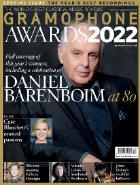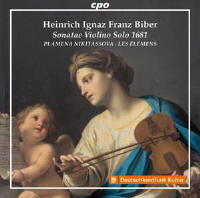Texte paru dans: / Appeared in: |
|
|
Outil de traduction |
|
|
As much as Biber’s Rosary (or Mystery) Sonatas of c1674 are wonderful, it does seem a shame that we only rarely hear his slightly later (1681) set of Eight Sonatas for violin and basso continuo. It was to these that he owed much of his contemporary fame, setting as they did a new benchmark for violin composition, thanks to their combination of technical and virtuoso demands, overall ambition and artistic substance. Biber’s famous love of scordatura is also on display – Sonata No 4 in D, for instance, uses the same a?e'?a'?d" retuning as used in the Rosary Sonatas’ ‘The Assumption of the Virgin’, while in the second half of Sonata No 6 the violinist gets a mere two-bar rest in which to retune the highest string down a tone; meanwhile, at the beginning of Sonata No 7, double-stops in second position (themselves a rarely employed device in Biber’s day) give the illusion of scordatura, despite the tuning in fact being standard.In other words, there’s plenty for the violinist and listener alike to get their teeth into. This album also contains the first recording of a stylistically similar sonata presumed to be the work of Biber’s pupil Johann Joseph Vilsmayr. Moreover, Plamena Nikitassova has gone oldest ‘old school’ with her Baroque technique, playing the violin on her chest rather than on the shoulder, and thus with a lowerarmed bowing technique in which the thumb is placed on the bow’s hair; and while the resultant violin sound arguably isn’t substantially different, beyond feeling slightly more rustic at points, Nikitassova’s own sound is lovely with the curve, ebb and flow of her phrasing, well-placed ornamentations and a wide range of colour and articulation. Take the climactic Sonata No 8, where Biber sets himself the technical challenge of giving the impression of a trio sonata from a single violin, and Nikitassova’s effective voicing of the ‘two’ violins seals the deal. Or the way her violin opens in husky whispers for Sonata No 5’s lilting chaconne, then moves to brighter sweetness, before gradually acquiring more edge as the passagework becomes more rapid and virtuoso. The neatness with which she dispatches the sonatas’ many virtuosities is also impressive, whether in the chains of double-stops in the same sonata’s fugal Presto, or in the sheer speed of, say, No 1’s chaconne (listen from 4'06").
Further imaginative variety comes via the continuo instrumentation choices, the keyboard part alternating between harpsichord and organ, pluckings between theorbo and baroque guitar, and bass strings between violone and viola da gamba. Sonata No 4’s Adagio, already soulful, is lent extra interest by the way the theorbo opens as chief accompanist, before the harpsichord seamlessly takes over.
One final nice touch is that Nikitassova performs most of the programme on a 1659 violin by Jakobus Stainer, the Tyrol luthier from whom Biber was supposed to be collecting a consignment of instruments in 1670 for his Moravian employer, the Archbishop of Olmütz (Olomouc), when he instead absconded to Salzburg in what appears to have been a carefully planned poaching operation by the employer under whose patronage his eventual fame was made possible, and to which this set is dedicated, Prince Archbishop Maximilian Gandolph von Kuenburg.
|
|




